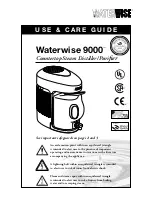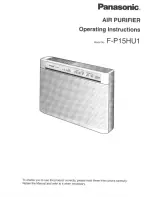
20
VG79D920H01
9-5. Piping connections and valve operations
Before heating the brazed sections, remove the gas and oil that are trapped in the pipes.
-Failure to do so may generate fire, resulting in serious injury.
Ventilate the room while servicing the unit.
-If the refrigerant leaks, oxygen deficiency may result. If the leaked refrigerant comes in contact
with a heat source, toxic gas will be generated.
Store pipes indoors, and keep both ends of the pipes sealed until just before making a
flare connection or brazing. (Store elbows and other joints in plastic bags.)
-If dust, dirt, or water enters the refrigerant lines, the refrigerant oil will deteriorate and the
compressor will malfunction.
Keep the service valves closed until refrigerant charging is completed.
-Failure to do so will damage the unit.
Place a wet towel on the service valves before brazing the pipes to keep the temperature of
the valves from rising above 120ºC (248ºF).
-Failure to do so may result in equipment damage.
Keep the flame out of contact with the cables and metal sheet when brazing the pipes.
-Failure to do so may result in burnout or malfunction.
Braze the pipes with a nitrogen purge to avoid oxidation.
-Oxidized flux inside the refrigerant pipes will cause the refrigerant oil to deteriorate and cause
the compressor to malfunction.
9-5-1. Removing the pinched connecting pipes
The unit is shipped with the pinched connecting pipes attached to the liquid- and gas-side service valves to prevent
gas leakage.
Take the following steps
①
through
③
to remove the pinched connecting pipes before connecting refrigerant pipes to
the outdoor unit.
①
Check that the service valves are fully closed (turned clockwise all the way).
②
Remove the gas in the pinched connecting pipes, and drain out all the refrigerant oil. (See
Ⓔ
below.)
③
Remove the pinched connecting pipes. (See
Ⓕ
below.)
O
S
Ⓕ
Ⓒ
Ⓒ
Ⓐ
Ⓐ
Ⓔ
Ⓓ
Ⓑ
<A>
<B>
<A>
Refrigerant service valve (liquid/brazed)
<B>
Refrigerant service valve (gas/brazed)
Ⓐ
Valve shaft
The unit is shipped with the valve closed. Keep the valve closed while connecting pipes or
evacuating the system. Open the valve upon completion of this work.
Turn the shaft counterclockwise as far as it will go (90˚) to open the valve, and clockwise to close
it.
Ⓑ
Stopper pin
Prevents the shaft from turning 90˚ or more.
Ⓒ
Service port
Through the service ports, you can charge refrigerant, remove the gas in the pinched connecting
pipes, or evacuate the system.
Ⓓ
Cap
Remove the cap before turning the shaft. Put the cap back on upon completion of all work.
Ⓔ
Severed section of the pinched connecting pipe
Ⓕ
Brazed section of the pinched connecting pipe
















































